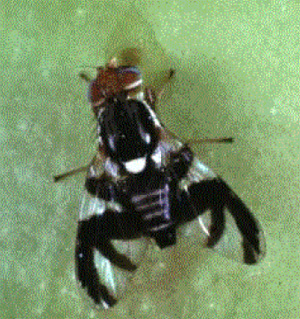Apple maggot alert for west central area growers
Rain from Monday, July 11 induced apple maggot emergence in Mason County. This is some 12 days earlier than last year.
|
Location |
2011 |
2010 |
2009 |
2008 |
2007 |
|||||
|
Date |
DD50 |
Date |
DD50 |
Date |
DD50 |
Date |
DD50 |
Date |
DD50 |
|
|
Hart |
||||||||||
|
Ludington |
7/12 |
934 |
6/30 |
893 |
7/25 |
950 |
7/11 |
847 |
7/19 |
1154 |
|
Location |
2006 |
2005 |
2004 |
2003 |
||||
|
Date |
DD50 |
Date |
DD50 |
Date |
DD50 |
Date |
DD50 |
|
|
Hart |
7/16 |
925 |
7/14 |
949 |
||||
|
Ludington |
7/19 |
1125 |
7/13 |
1084 |
7/19 |
975 |
7/14 |
855 |
*DD’s cited are for the day before.
The rain on Monday, July 11, began apple maggot emergence in Mason County, 12 days earlier than in 2010. Historically, first apple maggot catch would be by the end of June through the first part of July. Apple maggots overwinter as pupae and larvae are ready to emerge as adults in early summer when we have around 900 to 1,000 DD50. This year, they are just about on the normal schedule. The adults will continue to emerge from now through September. Usually, apple maggot flies are not residents in commercial orchards. They will move into the orchard from neighboring abandoned or neglected blocks.
 |
Apple maggot have a wide range of hosts: Besides apples, they will find a home for their young in hawthorns, crab apples, pears, apricots and plums. The fact that the flies are not fully sexually mature immediately upon emergence is presenting us with the opportunity to get our “defenses” ready. It takes about 7 to 10 days before they are ready to deposit eggs into the fruit. Generally, during that first 7 to 10 days upon emergence, they will not wonder too far from their emergence site. Females lay eggs over an extended period of time. Eggs hatch in about a week and the maggot starts tunneling through the flesh, causing discoloration and breakdown of the fruit. If the damage is severe enough, the fruit will drop on the ground, otherwise it will remain on the tree until harvest. Fully developed maggots find their way out of the fruit and drop on the ground and tunnel under the surface where they find a “home” to pupate and start the next generation.
If you are doing your own monitoring, remember to place the traps on the south to southwest end of a block, one to two rows in from the nearby wooded area or abandoned trees (most likely penetration hot-spots). Traps bated with ammonium acetate will have greater appeal to the flies than just color. Use four to eight spheres per block in order to get good representation of the activities in the orchard. Once at threshold (one fly in a trap), a spray should follow. Sprays are necessary throughout the emergence period (through early September). Frequency of the sprays will depend on the type of material used and its residual activity. Traditional materials have been Guthion, Imidan (organophosphates), Sevin (carbamate) and Asana (synthetic pyrithroid).
John Wise and Larry Gut, MSU entomologists, have done studies on some of the new-generation materials and found that Calypso and Assail (neonicotinoids) will provide excellent apple maggot control. Warrior, GF-120NF Fruit Fly Bait, Baythroid XL and Battalion are rated as good apple maggot materials.



 Print
Print Email
Email


